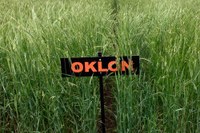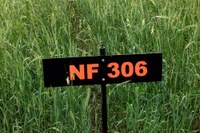Rye
Elbon
 The OAES released Elbon rye, which was mass selected and increased at the Samuel Roberts Noble Foundation, Inc. from seed obtained from the Oregon Agricultural Experiment Station.
The OAES released Elbon rye, which was mass selected and increased at the Samuel Roberts Noble Foundation, Inc. from seed obtained from the Oregon Agricultural Experiment Station.
Elbon has excellent winter forage production and early maturity. It has an upright growth habit and large soft stems. The forage has high moisture content, produces plants with have more winter growth, are more erect, and are approximately two weeks earlier than Abruzzi.
Elbon is best adapted to southern and eastern Oklahoma; however, it is recommended for use throughout the state. Elbon is winter hardy and will grow rapidly during the warm periods in the cold winter months. Late freezes may injure the plant but it will usually recover and produce a seed crop.
Maton
 Maton was jointly released by the OAES and the Samuel Roberts Noble Foundation Inc., Ardmore, Oklahoma, in 1976. A widely adapted, excellent tillering variety, Maton combines superior early forage production and increased total forage yield. It is equal to or better in late forage production compared to Bonel or Elbon in its primary areas of adaptation.
Maton was jointly released by the OAES and the Samuel Roberts Noble Foundation Inc., Ardmore, Oklahoma, in 1976. A widely adapted, excellent tillering variety, Maton combines superior early forage production and increased total forage yield. It is equal to or better in late forage production compared to Bonel or Elbon in its primary areas of adaptation.
Maton offers increased grain yields and improved disease tolerance particularly to leaf rust, septoria leaf blotch and anthracnose. It appears to be better adapted to southern Oklahoma and other southern states.
Its grain test weight is slightly less than that of Bonel and Elbon. In out-of-state tests, Maton yielded 106 percent of Bonel in average total pounds of oven dry forage per acre. It yielded 120 percent and 101 percent of Bonel in dry forage per acre in the fall/winter and spring respectively.
Oklon
 Oklon winter rye was developed by the Samuel Roberts Noble Foundation, Inc., Ardmore, Oklahoma, and jointly released in January 1993 by the Noble Foundation and the OAES.
Oklon winter rye was developed by the Samuel Roberts Noble Foundation, Inc., Ardmore, Oklahoma, and jointly released in January 1993 by the Noble Foundation and the OAES.
Oklon is increased from an individual plant selection in 1982 from Maton during nine years (1983-92) of testing at Ardmore. Oklon produced an average of 14 percent more fall and winter forage and 2 percent higher total forage than Maton. Seed production has averaged 8 percent less than Maton but 4 percent more than Elbon. At this location, winter hardiness of Oklon was similar to that of Maton. Oklon forage contains about the same crude protein as other forage ryes. The vegetative and seed characteristics are very similar to Maton. No consistent differences have been noted in lodging, plant height, disease and insect resistance between Oklon and Maton at Ardmore.
The main advantage of Oklon is improved fall and earlier winter forage production with increased total forage production in some environments.
Maton II Rye (NF306)
 Released by the Samuel Roberts Nobel Foundation, Maton II (NF306) is intended for use in fall through winter grazing systems and builds upon Maton, which was previously released by the Noble Foundation.
Released by the Samuel Roberts Nobel Foundation, Maton II (NF306) is intended for use in fall through winter grazing systems and builds upon Maton, which was previously released by the Noble Foundation.
Maton II produces more total forage compared to the commonly grown rye varieties in southern Oklahoma. More than half of its total yield produced during the early growing season. This variety is suited for light-textured and sandy loam soils. It is well adapted to southern Oklahoma, northern and eastern Texas, and the southeastern United States.
This variety is licensed to Oklahoma Genetics, Inc. OGI is a farmer nonprofit that distributes pedigreed seed to producers in Oklahoma and surrounding states. Producers must be members of OGI in order to purchase foundation seed for OGI varieties.





